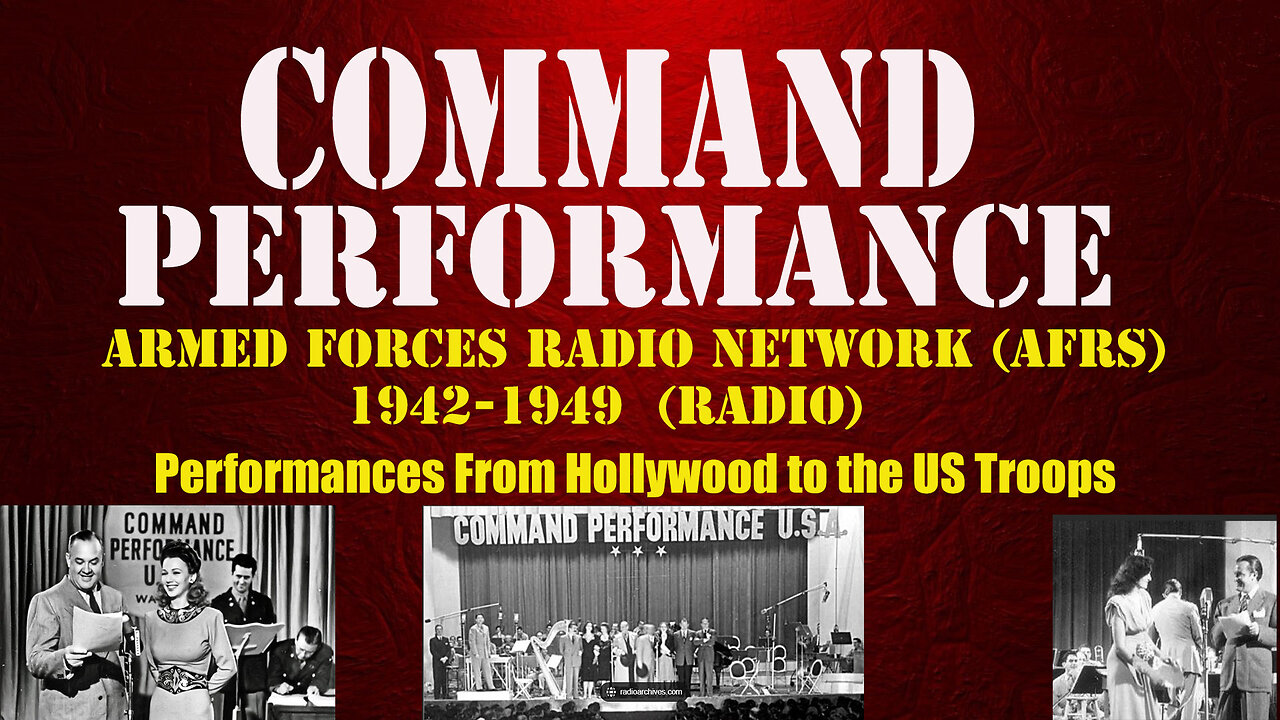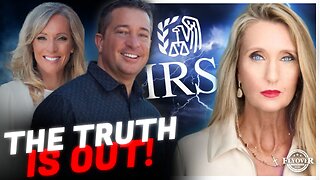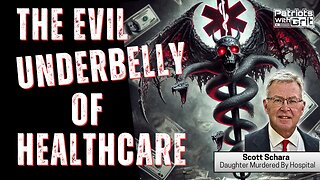Premium Only Content

Command Performance 42/03/01 (ep001) Eddie Cantor
I want to let the listeners know that if a song is about to play and the program skips over it, that means it was copyrighted and had to be omitted. Sorry folks, i know it can be frustrating but I have to follow the copyright laws. Some songs are copyrighted, but are allowed to be played, but YT will include commercials.
Command Performance was a radio program which originally aired between 1942 and 1949. The program was broadcast on the Armed Forces Radio Network (AFRS) and transmitted by shortwave to the troops overseas—with few exceptions, it was not broadcast over domestic U.S. radio stations.
Background
Most episodes of the program were produced before an audience in the Vine Street Playhouse in Hollywood, California, and recorded via electrical transcription. The weekly listening audience of was estimated at 95.5 million.
Troops sent in requests for a particular performer or program to appear, and they also suggested unusual ideas for music, sketches, or sounds from home on the program, such as: "Ann Miller tap dancing in military boots"; "a sigh from Carole Landis" or Lucille Ball; "foghorns on San Francisco Bay"; "Errol Flynn taking a shower"; "a slot machine delivering the jackpot" and "Bing Crosby mixing a bourbon and soda for Bob Hope". Top performers of the day appeared, including Bing Crosby, Jack Benny, Frank Sinatra, Bob Hope, Fred Allen, Ginger Rogers, Judy Garland, Lena Horne and The Andrews Sisters.
The first Command Performance was broadcast on March 1, 1942, almost exactly three months after the bombing of Pearl Harbor. It was produced under the aegis of the Office of War Information and its success paved the way for the creation of the Armed Forces Radio Service in May 1942. Time magazine described Command Performance as being, "the best wartime program in America". However very few listeners in the United States ever heard it and it would appear that the Christmas Eve Command Performance of 1942 was the only program of the series to be broadcast to a general audience. Variety magazine commented on this saying:
The War Department on Christmas Eve gave domestic listeners their first taste of a series that had been going out to the Armed Forces on short-wave for 43 consecutive weeks. The purpose of the special occasion as Elmer Davis, Office of War Information chief, expressed it in a foreword to the show, was to forge a link between the servicemen abroad and the folks on the Home Front. A recorded version of the show was short-waved, all over the world, the next day... Hope emceed, tossed off a monologue and cross-fired with Crosby.
Variety also observed that “sometimes the language on these shows is just a little more robust than is passed by standard broadcasting stations. Jack Benny, as we recall, last Sunday night encouraged our fighting men to ‘give ’em hell.'”
Transcription disc label for broadcast number 175 (May 17, 1945) of Command Performance, featuring Orson Welles
At the outset, the AFRS was shortwaving the shows but the reception was often distorted or spoiled by fading and static. Also, many servicemen had no access to a shortwave receiver. These problems were resolved when the Armed Forces Radio Service sought permission from the four major radio networks to record favorite programs on 16" transcription discs. As many as 70 of these programs were recorded and produced each week, especially for the armed forces, together with Command Performance, Mail Call, G.I. Journal, and various other series
Performers volunteered their talents for the program. An article in a 1943 issue of Tune In magazine estimated if "Presented by a commercial sponsor, Command Performance would have a weekly talent cost of $50,000." In addition, performing and production unions waived their rules for the war effort on the condition that the shows were only broadcast to service personnel.
The final episode of Command Performance—the 415th in the series—was produced in December 1949.
Dick Tracy in B Flat
One memorable program, No. 162, a 55-minute musical adaptation of Dick Tracy, was broadcast on February 15, 1945. Bing Crosby had the title role in Dick Tracy in B Flat with Dinah Shore as Tess Truheart and Jimmy Durante as The Mole. The supporting cast included Judy Garland, Cass Daley, Frank Sinatra, Frank Morgan, Bob Hope, Harry von Zell, Jerry Colonna, Lou Crosby, the Andrews Sisters and the Joe Lilley Chorus. The show managed to do what Tracy's creator, cartoonist Chester Gould, had never done - marry Tracy to Tess. The act opened with a Tracy - Tess wedding scene and song - “Oh Happy, Happy, Happy Wedding Day” which faded into the sound of an auto, the squeal of tyres, a machine gun burst and three pistol shots. Subsequent wedding scenes were interrupted by a bank robbery, a kidnapping and a hold-up with 13 people killed. "Most of the songs were clever parodies and the entire show was one big laugh from beginning to end."
-
 1:45:52
1:45:52
Redacted News
8 hours agoBOMBSHELL! Trump about to announce largest spending FREEZE in American history, deep state in PANIC
181K344 -
 1:05:23
1:05:23
Man in America
11 hours agoDeepSeek & the AI War to Dominate the New World Order w/ Mike Adams
26.7K7 -
 LIVE
LIVE
DLDAfterDark
2 hours ago $0.73 earnedDLD Live! Are They Planning an Attack?? The "cute winter boots" Trend & What it Means!
285 watching -
 55:26
55:26
Flyover Conservatives
22 hours agoFrom Conspiracy Theory to Proven Fact: Breaking Free from the American Corporation - Ann Vandersteel | FOC Show
26.1K3 -
 1:48:32
1:48:32
Danny Polishchuk
8 hours agoThe Funniest Call In Show On Earth - Live From New York City's Best Comedy Club
29.2K -
 1:01:12
1:01:12
The StoneZONE with Roger Stone
5 hours agoTrump Authorizes ICE Raids That Save Women and Children | The StoneZONE w/ Roger Stone
34.6K5 -
 1:39:36
1:39:36
Patriots With Grit
3 hours agoThe Evil Underbelly of Healthcare | Scott Schara
19.9K -
 1:30:54
1:30:54
megimu32
7 hours agoON THE SUBJECT: Music fun, Marvel Madness, and HOTSEATTODD!
27.8K1 -
 7:24:37
7:24:37
Dr Disrespect
12 hours ago🔴LIVE - DR DISRESPECT - WARZONE - NEW SEASON 2 UPDATE
178K29 -
 58:55
58:55
Candace Show Podcast
8 hours agoBACKSTABBED: Justin Baldoni’s Leaked Voicemail, RFK Jr’s Betrayal | Candace Ep 140
147K271